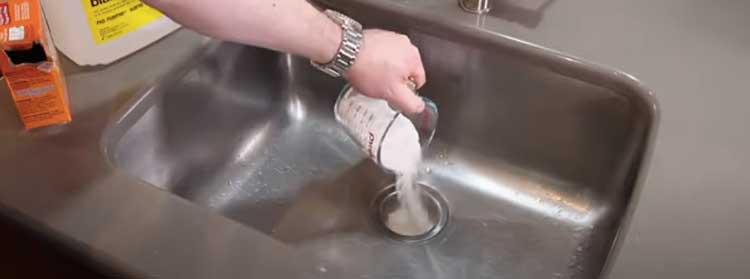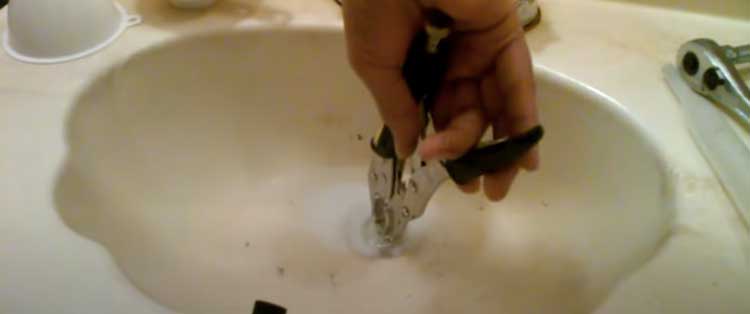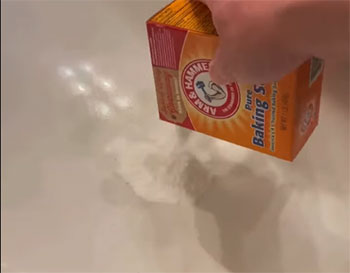Have you tried clearing those drain clogs using baking soda? I mean, it’s quite a popular method for clearing up those clogs on a drain. However, is it the safest method though?
There are plenty of situations where people complain about baking soda hardened in the drain. In short, they end up clogging the drain even more while using baking soda.
Now, this brings us to why that happens and what you can do to fix this.
Don’t worry; I won’t just leave you with the questions. Here, I will answer everything you need to know about baking soda and cleaning up your drain from all the clogs.
So, let’s get started with it without wasting any more time.
Is It Safe To Put Baking Soda And Vinegar Down The Drain?

Don’t get me wrong, baking soda and vinegar are still great DIY solutions for unclogging your drain. So, it’s not unsafe to use these as your cleaning agent.
The problem many people come across is with the ratio or quantity they use for cleaning up.
When you mess up the baking soda and vinegar ratio, you will end up with this problem. Now that was the answer if you were wondering, “Why does baking soda clog my drain?”.
I will go through the proper baking soda and vinegar ratio in a bit, so stick with me until the end.
Moving on, some other factors can cause baking soda and vinegar to be a bit unsafe.
You can also end up with hardened baking soda in your drain if there is too much grease and oil in your drain. Baking soda and vinegar solutions sure clear clog, but they are ineffective against fats.
So, if you are working with a drain that has clogged up fats like oils, grease, butter, and so on, then you are likely to come across this issue.
The vinegar and baking soda will foam up, but they won’t be able to clear the clog in your drain and may even get hardened further on.
Another issue that can be problematic with using baking soda and vinegar solutions is the damage to the plumbing.
This can happen when you rely too much on this solution and use it excessively. Too much use of this solution can damage your plumbing system.
Altogether, while baking soda and vinegar can work for clearing up drain clogs, they also pose some threats. They are not necessarily dangerous or unsafe, but you have to know where you are using them and how you are using them.
Now, let’s get through the proper ways to use baking soda and vinegar to clear up your drain.
How Baking Soda Hardens in Drains
To understand how baking soda clogs form, it helps to first look at why baking soda can work as a drain cleaner:
Abrasive Properties
The gritty texture of baking soda can help scrub away grease and sludge clinging to pipe walls when flushed down.
Alkalinity
Baking soda is alkaline with a high pH. This helps dissolve organic oils and acids that accumulate in drains.
Fizzing Reaction
When baking soda combines with vinegar and water, it creates satisfying bubbles and fizz. This agitation can dislodge built-up gunk.
However, that same fizzing reaction can work against you if the baking soda doesn’t fully flush away. Here’s what happens:
- Leftover baking soda lingers on the pipe walls after you attempt to drain clean.
- Small amounts of grease, hair, and soap remain stuck in the drainage too.
- Water condenses and mixes with the leftover baking soda.
- A chemical reaction occurs between the baking soda and fatty acids in the pipe gunk. This creates water insoluble fatty acid salts.
- These fatty acid salts act like a glue, bonding the baking soda into a cement-like mass along the pipe walls.
Over time, this baking soda concrete hardens even more and creates a new clog. So what was meant to clean your pipes can end up doing the opposite when improperly flushed!
Unclogging Drain With Baking Soda And Vinegar

Remember, you shouldn’t try this method if you are pretty sure that the clog in your drain is caused by too much fat.
In that case, you can either take professional help or try out different methods. Other than that, you can surely try this out for regular clogs without any hesitation.
The first thing you need to decide is the ratio of baking soda to vinegar to clean a drain?
It’s an essential part of this process. With the wrong ratio, you will end up with a clogged drain with baking soda.
The proper ratio for cleaning up a clog from your drain is one part of baking soda goes to two parts of vinegar.
So, if you are using 2 cups of baking soda, you will need to use 4 cups of vinegar along with it. This is the ratio you have to maintain for the solution.
But this isn’t the number you should be aiming for because the baking soda and vinegar quantity depend on the plumbing system and the size of your drainage.
The best solution is to start with a lower number; for example, you can start with 1 cup of vinegar and half a cup of baking soda.
If that doesn’t work, you can move on to increasing the quantity little by little. Now, let’s take a quick look at the process of doing this.
- First, you have to heat some water in a kettle or a cup which you can use to pour the water through the drain.
- After heating the water, you will need to pour some dish soap along with the boiling water into the drain. The reason for doing this is to clear up the clog that is greasy or fatty.
- Next up, you have to pour baking soda into your drain. You can either go with half a cup or go for a whole cup of baking soda. Measure the quantity correctly because you have to maintain the ratio.
- Right after the baking soda, you have to pour vinegar following the ratio of 1:2. So, if you are using half a cup of baking soda, you will have to follow up with 1 cup of vinegar.
And if you are going with one whole cup of baking soda, you will need to use 2 cups of vinegar. Once you hear the fizzling sound from the baking soda and vinegar combo, it should start clearing up the clog.
- After that, you have to wait for around 4 to 5 minutes. Then, you will need to pour some more boiling water. This flushes the drain and clears up anything poured into the drain.
Watch this video to learn more about this method.
If the clogs don’t clear in the first attempt, then you can repeat the whole thing one or two more times. But if that doesn’t work, then you may need to opt for another solution or hire professionals.
What To Do When Baking Soda Gets Hardened?
Assuming that you messed up the ratio and ended up pouring a lot of baking soda, you will come across this issue.
No need to worry there though, you can still fix this issue.
If you have clogged your drain using too much baking soda, all you have to do is pour vinegar into the drain.
You have to keep pouring vinegar until you feel like you have matched the ratio for the mixture.
Once you reach the proper ratio, the baking soda should automatically mix with the vinegar and unclog.
Things To Keep In Mind While Using Baking Soda And Vinegar Solution
There are several things you should always keep in mind when you are using this solution. Let’s get through them one by one.
- Always make sure you are maintaining the ratio.
- Don’t put too much of anything, neither baking soda nor vinegar.
- Avoid using this solution excessively.
- Never miss out on using boiling water initially and at the end.
- Don’t use vinegar before baking soda, as that doesn’t work at all.
Usually, maintaining these things is crucial for the method to work. Other than that, you always have to consider the fat and grease element inside the drain.
Preventing Baking Soda Clogs
An ounce of prevention is worth a pound of cure when it comes to baking soda drain mishaps. Here are tips to avoid this issue in the future:

- Always flush baking soda treatments with plenty of hot water, at least 8 cups.
- Don’t walk away once you’ve poured baking soda down the drain. Stay and keep flushing.
- Rinse with hot vinegar water after to fully dissolve any lingering baking soda.
- Limit sink use during and after baking soda treatments to prevent added oils and grease.
- Use a hair catcher to minimize build up of hair and debris that could react with unused baking soda.
- Clean drains regularly to limit accumulation of pipe gunk in the first place.
- Never pour baking soda down main line drains as a preventive measure. Stick to sink drains only.
- Avoid baking soda if you have cast iron pipes, as they corrode easily.
With proper use and flushing, baking soda can be a safe DIY drain cleaner. But learning how to prevent and remove clogs is a lesson many learn the hard way.
Now that you know what causes this cement reaction and how to clear it, you can harness the power of baking soda without the hassle!
FAQs
To dissolve a baking soda clog, pour hot vinegar or boiling water down the drain. Let react for 15 minutes before rinsing with hot water. Repeat as needed. Using a plunger, snake, or chemical cleaner are other options.
Methods to remove hardened baking soda include using boiling water, vinegar, salt and ice, a plunger, drain snake, or commercial drain cleaner chemicals. It takes dissolving the cement reaction and/or physically scraping out pieces.
Baking soda can clog drains when leftover bits inside the pipe react with small amounts of grease and oils. This forms a concrete-like mass that hardens over time. Proper flushing is key to prevent this reaction.
To break up baked on baking soda, use hot water, vinegar, salt and ice, mechanical force from a plunger or snake, or chemical cleaner to dissolve, scrape away, and dislodge the hardened chunks bit by bit.
Conclusion
In short, now you know why and how you have baking soda hardened in the drain, even if it’s a recommended cleaning solution.
Learning about the facts that I discussed and following the proper method can save you from all the trouble. You won’t even have to deal with this baking soda clog issue at all.

Thank you for the information. I have a clogged double-basin sink. I first tried using Instant Power Heavy Duty Drain Opener. It has sodium hydroxide as an ingredient. After that didn’t work, I added boiling water to the top of both sinks. That didn’t work either. Then I realized the blockage was probably from too much baking soda that was poured down the drains years ago to keep the smell down. The sink is never used. But a few days ago, I discovered a leaky faucet that filled and overflowed the basins. So now I scooped out as much as that water and Drain Opener as I could. Would it be worth trying to just pour vinegar in the drain to try to dissolve the cemented baking soda? Or would that be dangerous since there is probably still a little of the Drain Opener in there? Thanks for any help! Debbie